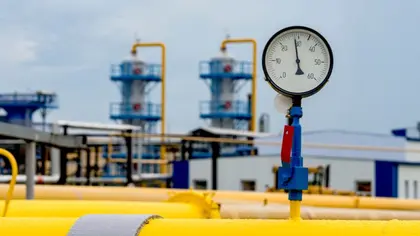Ukraine’s location and infrastructure can make it a crucial gas trading hub in east Europe. More trade gives Europe a larger and wider choice of gas suppliers, which means more security and lower prices for the continent.
Mykola Kolisnyk is Deputy Minister of Energy of Ukraine
JOIN US ON TELEGRAM
Follow our coverage of the war on the @Kyivpost_official.
Russia’s full-scale invasion of Ukraine has led to structural changes in the European energy balance. New routes are emerging, new markets are forming, and Europe is experiencing a gas infrastructure boom that will permanently change the configuration of energy systems and markets.
Ukrainian Minister of Energy Herman Galushchenko has repeatedly noted that Ukraine, with its own production, well-developed gas transportation system, large underground storage capacities and location at the crossroads of new supply routes, has actually become a new gas hub in Europe.
Europe benefits from this new activity in Ukraine. More gas trade on European soil means more gas suppliers. This means more flexibility for Europeans, reduced dependence on any one supplier, and potentially lower prices.
Experts historically considered Ukraine as part of the wider ‘Commonwealth of Independent States’ market, dominated by Russia. But gas transits from Russia should end this year, according to Ukrainian Energy Minister Herman Galushchenko.
Instead domestic production, new supply routes that bypass Russia and extensive Ukrainian gas storage facilities will create a new Ukrainian business model.

No Compromising With the Kremlin
Ukraine is a natural accumulator for European gas
Ukraine already has signs of a gas hub. The Ukranian Energy Ministry’s strategy is to attract non-residents to store gas in Ukraine.
Ukrainian underground gas storage facilities are an integral part of the European gas system. Out of total Ukranian storage capacity of 31 billion cubic meters, imports typically fill between 2.5 to 10 billion cubic meters. Ukraine stores gas from Poland, Norway, Hungary and even liquified natural gas (LNG) which arrives into Europe by ship.
In 2023 14.8 billion cubic meters of Russian gas transited through Ukraine to Europe. The same volume of gas can be sourced from other countries and stored in Ukrainian facilities during summer 2024. This can then cover the needs of eastern EU countries including Austria and Slovakia and others for winter 2023/24.
Ukraine’ gas storage facilities passed European certification in April 2023. Most of the storage capacity (25.3 billion cubic meters) is located in the west of the country, in five separate facilities which are reliably protected. This volume is 1.5 times higher than the combined storage capacity of Hungary, Romania, Poland, and Slovakia.
Ukraine already has a high level of implementation of European gas legislation in the gas market. This allows non-Ukranians to be customers of gas transport and storage infrastructure, and active participants in the Ukrainian gas market.
As part of the European Commission’s initiative to improve security of supply, the AggregateEU programme can purchase gas as it enters Ukrainian storage facilities. So Europe can have de facto guaranteed gas reserves in Ukraine.
Ukraine’s underground storage facilities are at the crossroads of European gas transportation routes and are closely connected to countries that are increasing their role in the European gas market, such as Poland and Romania.
Poland is actively developing its LNG infrastructure, and is connected to Denmark and Norway via the Baltic Pipe. If we also consider Lithuanian’s floating LNG plant, the total gas and LNG import capacity in the region hits 27 billion cubic meters. Ukrainian underground gas storage would help to load the terminals and provide dynamic supplies based on secure long-term contracts.
The signed long-term contracts for increased imports from the Caspian region, the substantial share of LNG in the Balkans as early as 2025, and the increase in supply volumes from the North and Barents Seas in the Baltic indicate that a new business model is being formed and the replacement of Russian gas is underway.
The EU seeks to abandon the use of Russian gas and to reduce the share of fossil fuels in the energy balance. Ukraine can help deliver on these goals.
You can also highlight the text and press Ctrl + Enter






